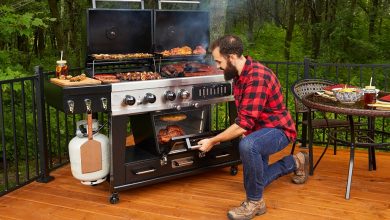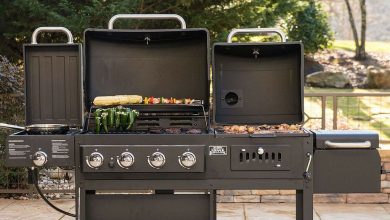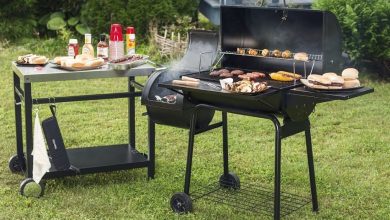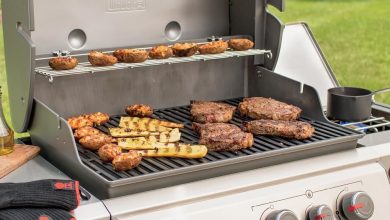Even though some people mix up ordinary offset smokers with reverse flow smokers, there’s actually quite a bit of difference between the two. Reverse flow models allow for even temperature distribution and superior smoke flow than offset models. This creates a cooking environment that is consistent throughout the entire smoking chamber and virtually eliminates hot spots. These models also return back to cooking temperature more quickly after the lid has been opened. However, that’s only the beginning of what these smokers can do. Anyone interested in finding out why these smokers are the ones that people are snatching up in record numbers is going to want to read our reviews of the best reverse flow smokers available, and after that, our guide on the subject.
- Editor’s Choice
Oklahoma Joe’s Longhorn Smoker (Amazon) – Review - Also Recommended
Oklahoma Joe’s Highland Smoker (Amazon) – Review - Also Consider
Char-Griller Smokin Pro 50-Inch Grill/Smoker (Amazon) – Review
Editor’s Choice: Oklahoma Joe’s Longhorn Smoker
This reverse flow smoker has so many features, it’s a bit difficult for us to know where to begin, so we guess we’ll just start with the dimensions of this smoker and work our way out from there. This smoker is approximately 35.5-inches by 64.24-inches by 55.5-inches. It’s a product that’s made from heavy-gauge steel and as a result of this fact, this smoker weighs approximately 226-pounds. Fortunately, it’s equipped with two wheels on it that help a little bit to move it into position.
Inside of this smoker, the consumer is going to notice a total of 1,060 square inches of cooking surfaces. 751-inches of that total is located in the main smoking chamber and the other 309 square-inches in located in the firebox chamber. On the firebox, the consumer will also notice a swing-open door that allows the consumer to stoke the fire and do it without opening the firebox chamber’s lid. That’s a very convenient feature for any smoker to have.
Another thing that we liked about this smoker was that it allowed the consumer to change smokestack locations. That allows the consumer to not only use this product as a reverse flow smoker but also allows them to use it as a traditional offset smoker. This allows the consumer to smoke their foods the way they see fit.
Additional features that can be found on this smoker include cool-touch handles, front and bottom shelves, a lid-mounted temperature gauge, four baffles, a large charcoal basket, and porcelain-coated wire grates. There’s even a warming area on top of the firebox that the consumer can use to keep plates warm.
Although this product costs a little bit more than other smokers in this category, it’s easy to see where the extra money is going. This is an extremely well-built reverse flow smoker and one that we think consumers are going to love using year in and year out.
– This smoker has 1,060 square-inches of cooking surface.
– It uses four different baffles to guide smoke through it.
– It has a swing-open firebox door.
– It costs a little more than other reverse flow smokers.
Also Recommended: Oklahoma Joe’s Highland Smoker
The next reverse flow smoker on our list is also made by Oklahoma Joe. This model is called the Highland and it is a less expensive and slightly smaller version of the Oklahoma Joe Longhorn smoker. This model is approximately 57-inches wide, 33.5-inches deep, and 53-inches high. It’s a smoker that’s made out of heavy-gauge steel so the smoker weighs just under 200-pounds.
Inside of this smoker, the consumer will find 900 square-inches of total cooking space. This cooking space is divided between 619 square-inches in the main smoking area and another 281 square-inches located in the firebox chamber. Inside of the firebox, the consumer will find a large stainless steel basket that’s used to hold the fuel for the smoker and a clean-out door that makes removing ash from the firebox quick and relatively painless.
What makes this product such a good reverse flow smoker is that it has a series of four baffles located inside of it. These baffles guide the smoke and heat through the main chamber. This prevents hot spots and allows for more even cooking across the entire smoking chamber. As was the case with the Oklahoma Joe Longhorn smoker, this model can be used as either a traditional offset smoker or a reverse flow smoker. All the consumer has to do is to move the smokestack to switch from one type of smoking to another.
If there was a problem that we had with this smoker, it’s the fact that the thermometer seems to be a little bit off. It wasn’t as accurate as we thought it was. This isn’t a big problem and is easily rectifiable, but it is worth mentioning. The features we liked, however, were quite numerous. We loved the front and bottom shelves, the stay-cool handles, the wheels underneath the side of the main smoker chamber, and the warming area on top of the firebox for keeping plates warm. Taking all of this into consideration, we have no problem recommending this product to anyone searching for a reverse flow smoker.
– It features 900 square-inches of total cooking surface.
– Uses four baffles to achieve true reverse flow operation.
– It’s made using heavy-steel construction.
– The thermometer doesn’t isn’t as accurate as it should be.
Also Consider: Char-Griller Smokin Pro 50-Inch Grill/Smoker
The last reverse flow smoker that we’d like to talk about is actually a smoker/grill combo. It’s a model that’s made from powder-coated steel and is approximately 62-inches by 29-inches by 50-inches and weighs just under 150-pounds. Let’s take a closer look at some of the other features.
Inside of this smoker/grill is 830 square-inches of total cooking space. That cooking space is divided between 580 square inches of primary cooking area and 250 square-inches of cooking space in the firebox. The smokebox also has a warming plate on it that’s good for keeping plates warm while the consumer is using the smoker.
This smoker also has an adjustable fire grate that the consumer can move up and down as needed. Inside of the hood is a thermometer that’s perfect for keeping an eye on the temperature, too. There is also an air damper that helps the consumer control airflow into the firebox and into the main smoking chamber.
Other features include side and front tables that give the BBQ cook a bit of workspace while they’re smoking and/or grilling, two wheels for easy mobility, and nonstick cast-iron cooking grates that allow for even cooking. It also features an easy-to-dump ash pan, a side firebox door for tending to coals, and a lower shelf underneath the grill that can be used for storage.
All of these features come together to make this a smoker that some people might want to consider, even though it does cost a little more than comparable models. We felt it was well-made and did a good job for what it was designed to do.
– It provides a total of 830 square-inches total cook space.
– It’s easy to use and smokes/grills well.
– It’s a little bit expensive.
We understand that not everyone might be familiar with these types of smokers, so we wanted to make sure that we not only reviewed the best reverse flow smokers available but also took the time to write a comprehensive guide on the subject. In this guide, consumers will find the information they need to make the best decision possible when choosing a new reverse flow smoker.
What Is A Reverse Flow Smoker?
Our first lesson in this guide is to lay out the definition of reverse flow smokers. These smokers are very much like offset smokers—except they have a few key differences. For one, they have a sealed drip pan under the smoker that forces the smoke to travel from the firebox to the far side of the smoking chamber before it can rise and come in contact with the food. It also has a smokestack that’s located at the far end of the smoking chamber, so that once the smoke rises, it has to travel the entire smoking chamber before it exits the smoker. This forces the smoke over the entire length of the smoking chamber.
The Pros & Cons Of Reverse Flow Smokers
Now that we understand the mechanics that underpin these smokers, it’s time to turn our attention to their pros and cons. While a lot of guides will have consumers believe that these smokers are all pros and no cons—especially the ones trying to sell new smokers—the truth of the matter is that these smokers might not be for everyone. Let’s take a quick look before moving on to our section on buying a new reverse flow smoker.
Pros:
- They return back to smoking/cooking temperatures more quickly after opening the chamber door.
- They don’t experience temperature spikes after additional fuel is added to it.
- Smoke is distributed equally over the food in the smoking chamber.
- The smoker distributes moisture and flavor as rendered fat sears on the griddle pan of the smoker.
Cons:
- It can be difficult to remove the smoker’s steel plate because it’s welded in.
- If not used properly, these smokers can over smoke meats.
- They take longer to reach optimal smoking temperatures.
Okay, now it’s time to turn our attention to how to purchase these smokers. The following points are some of the things that consumers are going to want to think about when they’re choosing their next reverse flow smoker or buying one for the first time.
Step One: Consider The Size Of The Smoker
One of the first things that consumers are going to want to think about before purchasing a new reverse flow smoker is the size of the model they’re interested in. Not only are they going to want to consider how much total cook space the model has, but they’re also going to want to think about the overall size of the smoker. After all, these smokers tend to be large and to take up a lot of space, so the consumer is going to want to make sure that they have the space to use the smoker safely.
Step Two: Consider The Construction Of The Smoker
The next thing that the consumer is going to want to look at when they’re searching for a new smoker is what it’s made from. Consumers should make sure that they purchase a model that’s made with heavy-gauge steel or cast-iron. Thicker metals radiate heat better and create a better end product.
Step Three: Consider The Firebox
Next to the smoking chamber, the firebox is the next important part of the smoker. The consumer should make sure they choose one that’s of decent size and that it has a side access door so the fuel can be tended without having to open the firebox completely. Since most reverse flow smokers also use the firebox for additional cooking space, it’s also a good idea to make sure that it’s large enough to suit the consumer’s needs.
Step Four: Consider Some Final Details
Okay, since we’ve already spent quite a bit of time talking about these smokers already, we’ve decided that it was time to spend the last few moments of this guide talking about some of the additional features that consumers might want to think about before purchasing a new model. The following features all have an impact on how easy the smoker is to use and/or how well it works.
- A Quality Thermometer
- Wheels And/Or Casters
- Moveable Smokestack
- Easy-To-Dump Ash Tray
- Number Of Air Dampers








